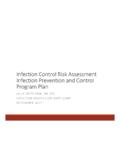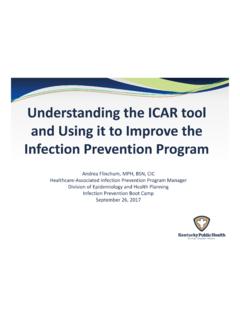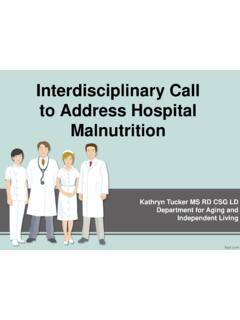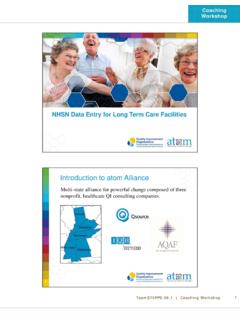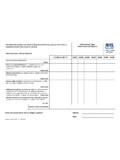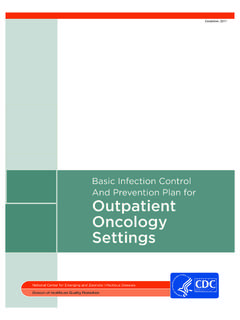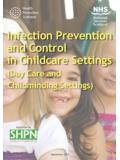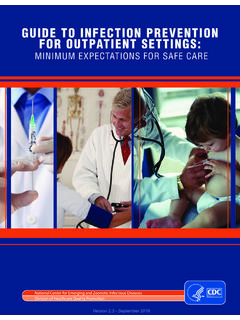Transcription of The Infection Control Risk Assessment and Plan - k …
1 The Infection Control Risk Assessment and PlanJudy Keen, RN, BSN, CICW hich comes 1stthe chicken or the egg?Risk AssessmentInfection Control and Prevention PlanCOMMUNICABLE DISEASE REPORTEDTOTAL REPORTEDCAMPYLOBACTER1 CHLAMYDIA1 HEPATITIS B6 HEPATITIS C24 HIV2 INFLUENZA A SUBTYPE H31 LYME DISEASE1 PERTUSSIS1 ROCKY MOUTAIN SPOTTED FEVER2 SALMONELLA1 SHIGELLA1 STEPTOCOCCUS PNEUMONIAE (INVASIVE)3 SUSPECTED TB/TB12 Employee exposuresEmployee immunizationsCommunity outbreaks/threatsAntimicrobial StewardshipSyndrome surveillanceINFORMATION OVERLOADHELP!!!!!!!!WHERE DO I START?Annual Infection Control Program Review Data aggregation and analysis Healthcare-acquired Infection trends Compliance with Infection Control standards Communicable diseases (prevalence rates, incidence rates) Acknowledge achievements and challenges Presented as a stand alone document Annual review and approval by the Infection Control Committee Basis of the annual risk assessmentTHE COMPREHENSIVE RISK ASSESSMENTP otential risks /ProblemsPROBABILITY OF OCCURRENCERISK/ IMPACT ON PATIENTS, STAFF, AND VISITORSORGANIZATION PREPAREDNESS TO ADDRESS RISK AT THIS TIMERISK LEVELSCOREHigh (3)Med (2)Low (1) Life Threat (3)Perm Harm (2)Temp Harm (1) Poor (3)Fair (2)Good (1)
2 TOTALG eography and CommunityPrevention ActivitiesExample Risk Assessment GridPURPOSE OF THE RISK Assessment GRID Rank risks by score to determine organizational priorities Assist in determining where to focus available resources Provides basis for developing The Infection Control Plan Identify gaps in Infection prevention measures/processes Communication tool provide leadership and patient care providers with known and potential risks which can directly affect our patients The Annual Risk AssessmentWhat do I want to include from the annual review? Identified infections with the highest probability and potential for harm (known risk, potential risk, contamination, exposures) Identified environmental issues/concerns Identified organizational areas of weakness Emergency preparedness (Internally and Externally) National Patient Safety Goals have patient safety issues been identified Conditions of Participation does your organization meet CMS health and safety standardsGoal 100% Isolation Observations 1,872, Compliant 1,771 2016 Compliance 95% Improvement in isolation compliance has consistently improved.
3 Year Compliance 2013 84% 2014 89% 2015 90% 2016 95% Daily isolation rounds are done. When making isolation rounds the Infection Preventionist looks for appropriate signage for the communicable disease/disease process, isolation caddies are stocked with appropriate personal protective equipment (PPE), employees wearing appropriate PPE dedicated equipment, disposing of PPE properly, hand hygiene on entering and exiting the isolation room, and patient/family education.
4 Annual Program Review Use Historical Data, Example 1:Organization challengeAnnual Program Review Use Historical Data Example 2:Community challenge2016 COMMUNICABLE DISEASE REPORTING REPORTABLE DISEASES/CONDITIONS TOTAL REPORTED Campylobacteriosis 11 Chlamydia trachomatis 2 Cryptosporidiosis 1 Ehrlichiosis 4 Hepatitis A 2 Hepatitis B 14 Hepatitis C 115 HIV 2 Legionellosis 2 Lyme disease 4 Pertussis 4 Rocky Mountain Spotted Fever 3 Salmonellosis 1 Shigellosis 1 Syphillis 2 Suspected tuberculosis 8 (2 confirmed acute) Arboviral diseases (Zika) 2 Risk Assessment Components Geographical area served Population served Environmental issues Access to healthcare Prevalence of chronic disease Emergency preparedness Availability of equipment/supplies Public health Services provided including areas of specialization Actual data collected and analyzed from previous year Prevention measures consistent with evidence based practicesExternal Risk FactorsoAvailable servicesoGeography oEnvironment oPrevalent diseases and conditions oEmerging infections oHigh risk populationsDEFINE THE GEOGRAPHIC AREA AND POPULATION SERVEDI nternal Risk FactorsoPatients oEmployees oProcedures oDevicesoChronic diseases and conditionsoNumber of acute care facilities in the service areaoAntibiotic prescribing practicesoSocioeconomic statusoPrevalence of MDROs/CDI in the community/districtoSenior populationoSubstance abuseoImmigration populationCOMMUNITY CHARACTERISTICSFACILITY CHARACTERISTICS Number of licensed beds Number of
5 Clinicians and licensed staff Specialty services provided Affiliates such as physician practice, wound care center, cancer treatment center, etc. Construction/Renovation Specific units within the facility ( , ICU, NICU, Dialysis) Invasive devices, invasive proceduresOTHER RISK FACTORS TO CONSIDERoAntibiotic prescribing practices oSkilled Nursing Facilities, intermediate and personal care facilities/homes, Home Health Agencies, Durable Medical Equipment Providers, HospiceoAffiliation with local community colleges/universitiesoVolunteer program(s)oResidency ProgramRISK Assessment GRID SCORING2017 Infection Prevention and Control Risk Assessment Potential risks /Problems PROBABILITY OF OCCURRENCE RISK/ IMPACT ON PATIENTS, STAFF, AND VISITORS ORGANIZATION PREPAREDNESS TO ADDRESS RISK AT THIS TIME RISK LEVEL SCORE Expect it (4) Likely (3) Maybe (2) Low (1) Life Threat (3) Temp loss of function (2) Min Clinical or financial (1) Poor (3) Fair (2) Good / Solid (1) TOTAL Geography and Community Chronic diseases and conditions (diabetes, obesity, asthma, renal failure, lung disease)
6 4 3 1 12 Behavioral risk factors (tobacco use, substance abuse, poor dietary habits, lack of physical activity) 4 3 1 12 Prevalence of MDROs/CDI in the community/district 4 3 1 12 Senior population 4 3 1 12 Unvaccinated in the community-increased risk for communicable disease transmission 2 3 1 6 Immigrant population, international travel 4 3 2 24 RISK Assessment GRID SCORINGP otential risks /Problems PROBABILITY OF OCCURRENCE RISK/ IMPACT ON PATIENTS, STAFF, AND VISITORS ORGANIZATION PREPAREDNESS TO ADDRESS RISK AT THIS TIME RISK LEVEL SCORE Expect it (4) Likely (3) Maybe (2) Low (1) Life Threat (3) Temp loss of function (2) Min Clinical or financial (1) Poor (3) Fair (2) Good / Solid (1) TOTAL PREVENTION ACTIVITIES Potential for influx of patients with communicable disease(s) as only Acute Care Hospital for the Lake Cumberland District 2 3 1 6 Non-compliance with standard precautions including hand hygiene/respiratory hygiene and cough etiquette 1 3 1 4 Non-compliance to Transmission Based Precautions (Contact, Droplet, Airborne) 2 3 1 6 Lack of necessary PPE & appropriate PPE (increase need for supplies during outbreaks (nation, state, local) 3 3 1 9 Failure to implement EBPs to prevent hospital acquired pneumonia in a community where chronic lung disease, stroke, obesity, etc.)
7 Increase the risk for developing pneumonia 2 3 1 6 Failure to educate patient/family in prevention of Infection and preventing transmission of infectious diseases 2 3 2 12 RISK Assessment SCORING Multiply the ratings for each risk in the area of probability, impact and organization preparedness = Risk Score Ranking our risks by total score to help identify priorities sort in order of risk Priorities are used in the development of the Infection Control Plan WHAT COMES NEXT?THE ANNUAL Infection Control PLAN Number priorities according to the risk scores Purpose, Goals, Responsibility, Reporting, Authority Statement, Resource Allocation, Data Collection, Surveillance Method(s), Allocation of Time, Scope of Care Measurable goals (zero CLABSI) Strategies/Interventions the organization will use to achieve goals Responsible person(s) Time frame Method of evaluation2017 Infection PREVENTION PRIORITIES1. Surgical complication preventiona. Cleaning/Disinfection/Sterilization of equipment/instrumentsb.
8 Compliance with EBPs to prevent SSIs (modifiable risk factors such as surgical attire, cleaning and disinfection of instruments)a. Environmental cleaning in the ORb. Postoperative pneumonia1. Healthcare associated pneumoniaa. Increase activity/ambulation as toleratedb. Deep breathingc. Oral care1. Environmental Cleaninga. Patient care areab. Terminal cleaningc. Insect controld. Storage of patient care supplies1. Device Related Infection Preventiona. Foley catheter related urinary tract infections (focus on removing unnecessary FCs)b. CVC related infections (remove unnecessary CVCs/aseptic technique)c. Ventilator management/Ventilator BundleInfection Prevention and Control Plan 2017 Potential risks /Problems Goals Strategies/Interventions Responsible person(s) Timeframe Method of EvaluationPRIORITY 1: PROCEDURE RELATED risks Prevent Surgical Site Infection Rationale: Surgical site infections are the most common healthcare-associated Infection , accounting for 31% of all HAIs among hospitalized patients.
9 SSIs are a substantial cause of morbidity, prolonged hospitalization, and death. SSI is associated with a mortality rate of 3%. 1 of every 24 patients who have inpatient surgery in the develops an SSI. Procedures involving contact with a medical device or surgical instrument with a patient s sterile tissue or mucous membranes poses a major risk of introducing pathogens which can lead to Infection . Failure to properly clean, disinfect or sterilize equipment may lead to Overall SSI rate Colon = Number SSI/Expected SSI TAH = Number of SSI/Expected SSI Bi-monthly duodenoscope culture negative 100% percent compliance with defined process for cleaning, disinfecting and sterilization of critical and semi-critical devices and instruments 100% compliance with use of low level disinfectants for non-critical items Reprocessing of Instruments Flexible endoscopes and accessories will be pre-cleaned at the point of use Endoscopes will be processed in area designed and constructed to support processing activities Flexible endoscopes and accessories will be pre-cleaned at the point of use.
10 After pre-cleaning at the point of use, contaminated flexible endoscopes and accessories will be transported to the endoscopy processing room Flexible endoscopes designed to be leak tested should be leak tested after each use After leak testing and before HLD or sterilization, flexible endoscopes will be manually cleaned Flexible endoscopes and accessories will be visually inspected for cleanliness, integrity and function before use After manual cleaning and inspection flexible endoscopes and accessories will be HLD or sterilized. Flexible endoscopes and accessories should be stored to minimize contamination and protect from damage Central Sterile Processing Surgical staff, surgeons, anesthesiologist Materials Management Laboratory Plant Operations Annually January 1, 2017-December 31, 2017 Colon/TAH Reportable throuNHSN SIR = Observed HAIs Expected HAIs SSI RATE (All other) = Total SS_____ Total no. of procedures = ra SSI rates per 100 operative procedures are calculated bdividing the number of SSIs the number of specific operative procedures and multiplying the results by 10 SSI rate calculations are performed separately for different types of operative procedures and stratified bythe basic risk index.
